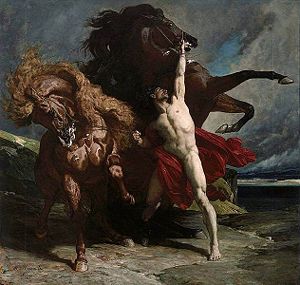Iliad

The Iliad is an epic poem from ancient Greece written by Homer probably around the seventh century BCE or earlier, which was written in dactylic hexameter and described a few weeks in the final year of the Trojan War. The main hero is Achilles, and while the Greeks battle the Trojans including prince Hector and Paris on the side of King Priam, a dispute regarding the importance of military valor arises between Achilles and the Greek leader, King Agamemnon. The Iliad details the interactions of Greek gods and humans during the war. The other main characters include Odysseus, Aias or Ajax, Menelaus, Diomedes, Patroclus, Deiphobus, Polydamas, Agenor,Dolon, Antenor, Polydorus, Hecuba, Helen, Andromache, Cassandra, Briseis and others, including a mention of Aeneas who later figures prominently in the Aeneid by Virgil. The gods include Zeus, Hera, Artemis, Apollo, Hades, Aphrodite, Ares, Athena, Hermes, Poseidon, Hephaestus, Eris, Iris, Thetis, Proteus, Scamander. The Iliad is a major work in Western civilization that has influenced countless other literary works. It was a cornerstone of culture in Ancient Greece. It has been copied and translated numerous times.